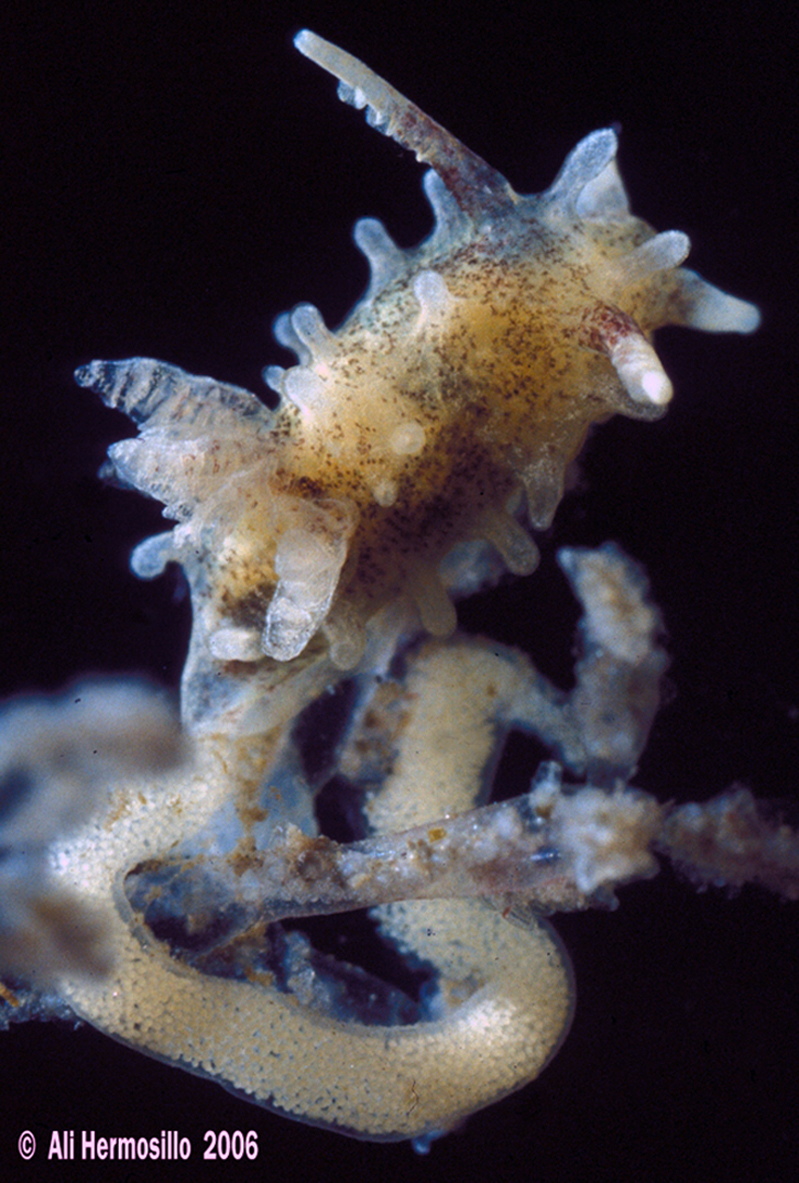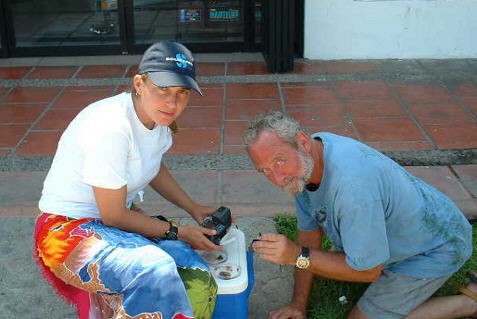 |
Okenia angelensis
Photo courtesy of Ali HermosilloAn interesting, small, eastern Pacific nudibranch, this species has not appeared as a BOW. Since a recent In Memoriam was presented on this site to respect Jim Lance, it is exceedingly appropriate to post the non-synonymized species he named which have not yet been BOWs.
Of Lance's seven “valid” nudibranch species, Cadlina limbaughorum appeared as BOWs 316 and 369; Histiomena convolvula was BOWs 63 and 360 (PDF File); and Peltodoris lancei numbers 251 and 504 , the last featuring his complete bibliography and list of all species he named (with synonymies), and 2 patronyms in his honor. This week Okenia angelensis is featured. Future BOWs will illustrate and describe Stiliger fuscovittatus, Corambe steinbergi, and Thordisa bimaculata.
The holotype and 4 paratypes of Okenia angelensis were all collected at Bahía de los Ángeles (Baja California, on the Sea of Cortez; 28E 55' N; 113E 32' W), in the lowest intertidal zone, on 7 May 1961, during Jim's occasional spring low-tide hajj. He reported the finding of additional specimens of this new species in central and southern California habitats: San Francisco Bay, Monterey Bay, Santa Barbara Yacht Harbor, and San Diego's Mission Bay. Subsequent observations and collections of O. angelensis have resulted in its present known range from San Francisco Bay, California, to Chile (and inside the Gulf of California, at Bahía de los Ángeles) (see Behrens & Hermosillo, 2005).
Let me quote from Lance's original, quite detailed description: “The largest adult specimen examined was 10 mm long and 2.5 mm broad when actively crawling....
“The body is firm in texture and elongate with high vertical ridges and a prominent pallial ridge extending beyond the foot margin ( (Figure 9) . The ridges unite behind the branchiae to form a median crest which rapidly terminates on the flat, rounded tail. Anteriorly the ridges continue in front of and below the rhinophores. On each side the pallial ridge gives rise to 6–9 robust digitiform papillae which project outward in a more or less horizontal plane....Five or six similar papillae more or less equidistant from each other occur on the notum between the rhinophores and branchiae—primarily on the pericardial hump....
“The color pattern is drab and along with the animal's diminutive size renders it very inconspicuous. The ground color is translucent white with the pale yellowish internal organs faintly showing through in the mid-dorsal region. The entire body except the foot sole is sparsely flecked with minute yellowish and white granules. Varying concentrations of reddish-brown dots, often gathered into irregular patches and streaks, occur over this same area but not on the papillae or other appendages except for the proximal half of each rhinophore and occasionally on the principal stems of the branchiae. In some slugs concentrations of subepidermal bluish-green pigment are found along the dorsal and ventral margins of the pallial ridge and on the body sides at the junctions with the foot.
“The nonretractile rhinophores are long, tapering rods set apart from each other. Their apices are rounded, not flattened. Most specimens bear one to three incomplete lamellae along the posterior surface of each rhinophore, although these sensory organs are completely smooth in some individuals....
“There are five to seven nonretractile gills separated at their bases. The antero-median member is the largest and is often deeply bifurcate near the insertion of the primary stem....
“The radular teeth are typical for the genus (Figure 11) . In a typical specimen 7 mm in length the formula was 21 x 1.1.0.1.1. The first lateral tooth is hamate with a broad base and on its inner side bears a linear series of 25–30 denticles which progressively increase in size from the base of the hook toward its tip. The flattened marginal teeth are oval to subquadrangular in outline and bear a single prominent notch, the points of which may be somewhat elongated. No jaws or labial cuticle were observed.”
There are 7 other species of Okenia reported from the eastern Pacific: Okenia academica Camacho-García & Gosliner, 2004; Okenia angelica Gosliner & Bertsch, 2004; Okenia cochimi Gosliner & Bertsch, 2004; Okenia mexicorum Gosliner & Bertsch, 2004; Okenia plana Baba, 1960; Okenia rosacea (MacFarland, 1905); and Okenia vancouverensis O”Donoghue, 1921.
References
Behrens, David W., and Alicia Hermosillo. 2005. Eastern Pacific Nudibranchs: A guide to the opisthobranchs from Alaska to Central America. Sea Challengers, Monterey, CA. vi + 137 pp.
Lance, James R. 1966. New distributional records of some northeastern Pacific Opisthobranchiata (Mollusca: Gastropoda) with descriptions of two new species. The Veliger 9 (1): 69–81.
Imperial Beach, California
August 2006
Photo courtesy of Ali Hermosillo
Send Hans email at hansmarvida@sbcglobal.net
|

